If you’re new to playing guitar, you’re probably feeling overwhelmed by all the different kinds of gear you can pick and choose. Even when it comes to small and seemingly unimportant parts, you’re probably faced with many choices, and you’re unsure what to pick. This can especially be true for guitar pickups since it may seem as if there’s not much difference between them – but a pickup can make a huge difference in sound quality.
Guitar pickups sound different primarily because of their type. The two main types are single-coil pickups and humbuckers. A pickup’s build, the materials they consist of, the position on the guitar, and how close to the strings they are will also impact how they sound.
If this sounds like rocket science, worry not because I’ll take you on a dive right into the nitty-gritty of tone differences between pickups. I’ll look at single-coil pickups and humbuckers, then examine the other factors that will influence your sound.
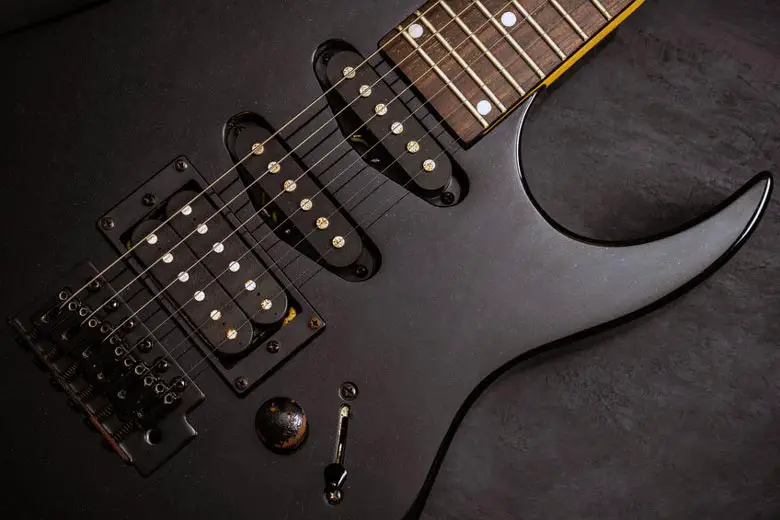
What Are Pickups and How Do They Work?
Before we plunge into the different kinds of pickups, we have to briefly look at what pickups do and how they do it. Otherwise, it’s going to be hard to understand the specifics.
A pickup is a thin wire insulated with paint that winds around a few magnets. It’s a transducer that modifies and amplifies the vibrations from guitar strings so the guitar cable can transmit them to the amplifier.
Saying that a guitar pickup is a transducer is a fancy way of saying it is an electronic device that turns one form of energy into another.
When you pluck a guitar string, it vibrates, and the task of the pickup is to pick up those vibrations (hence the name). This vibration creates an alternating current in the pickups, which modifies its flow.
This current then flows from the pickup to the instrument controls. Then, the waves go down the cable to the guitar amplifier from these controls, resulting in a fully amplified sound.
This lengthy process of sound transformation points to how critical your pickups are.
They are the first thing that significantly influences your sound (apart from the strings), so they’ll have a ton of influence over the quality of your final sound.
Even if you have a superb amplifier, it will not give you its best performance if the sound comes from bad pickups. Therefore, it is essential to choose your pickups carefully.
Now that we have a basic understanding of guitar pickups, let’s look at the different types of pickups and how they will influence your sound.
What Types of Pickups Are There?
There are two main types of pickups, based on how many coils they have. There are single-coil and humbucker pickups.
Some other types also exist, but they’re mostly just variations of these two types.
Let’s dive into the differences between these pickups and see what other variations they have inspired.
Single-Coil Pickups
Single-coil pickups are relatively self-explanatory. They have a single wire coiled around multiple magnets.
They usually have a bright sound, which is perfect for types of music in which you don’t have to rip out some brutal riffs.
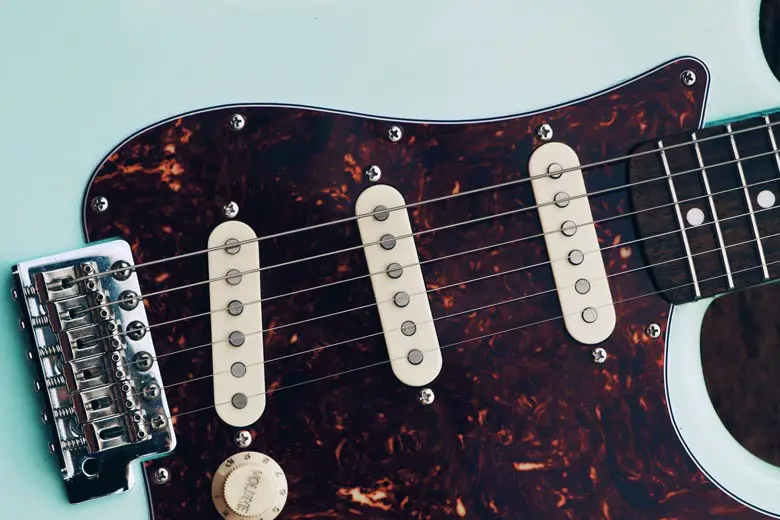
These pickups are the oldest type and are probably responsible for the recognizable sound of Fender guitars.
However, despite their bright and warm tone, they are not without problems. They are susceptible to interference, which can produce a hum or the so-called “60 cycles.”
There are a couple of significant single-coil variations. These variations are:
- P90
- Jazzmaster pickups
- Jaguar pickups
- Z coil
- Toaster pickups
- Lipstick pickups
P90 Pickups
The aim of creating the P90 pickup was to eliminate the hum that single-coil pickups often have. They predate humbuckers.

In terms of tone, they emphasize the middle tones, while the top tones are usually not particularly clear. Some players have also described their sound as muddy.
However, some see this as a pro rather than a con, so this will depend on your preferences.
Jazzmaster Pickups
A Jazzmaster pickup is a single-coil variation created for the Jazzmaster guitar. Many people mix these pickups with the P90s, but some structural differences exist.

In the P90s, the magnets are placed under the coils, while in Jazzmaster pickups, the magnets double as pole pieces. In Jazzmaster pickups, the coil winds in the opposite direction of P90 coils, thus influencing the sound.
Jazzmasters are also heavy on the middle tones while being less muddy. The top tones are also brighter, making them more versatile and clearer.
Jaguar Pickups
These pickups are also an attempt at reducing the hum created by P90 pickups. Their sides include metal teeth that mute humming, thus creating a clearer sound.

They’re usually mounted in the guitar’s body and not on the pickguard.
They don’t sound much different from typical single-coil pickups. However, their top tones may sound harsh to some people, but that may just be a personal preference.
Z Coil
The typical pattern we can see here is that most of these pickups are attempts to eliminate the hum that plagues single-coil pickups. The Z coil is another attempt at this.
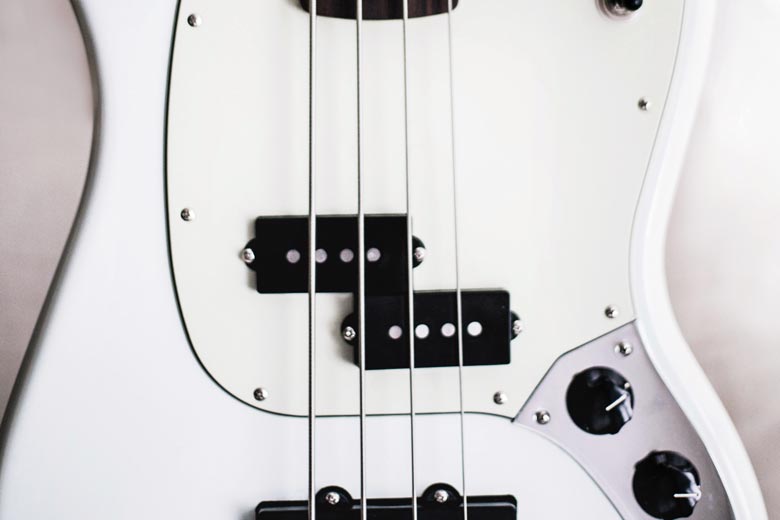
This pickup is essentially a single-coil pickup in two parts, shaped like the letter “Z.”
You can think of it as a single-coil humbucker since it does an excellent job getting rid of the hum and interference.
Apart from the lack of interference and noise, it doesn’t sound much different from a regular single-coil pickup.
Toaster Pickups
These pickups, which resemble the household appliance that gave them their name, come in single-coil and two-coil variations.

They were popularized by Rickenbacker and English musicians like John Lennon.
Their focus is on the top tones, while the middle and low sounds are not their specialty. They also produce a unique ring at higher frequencies, making them great for rhythm guitars.
Lipstick Pickups
Last but not least, lipstick pickups include a single coil that is much longer than the other varieties.

These vintage-looking pickups have a metal cover and a more extended bar magnet.
Like most vintage pickups, they don’t produce good bass sounds but instead focus on creating a blaring top that stands out.
Humbuckers
Humbuckers eliminate the hum that single-coil pickups produce. They are essentially two single-coil pickups in a pair. However, these two pickups run in alternating directions (electrically and magnetically).
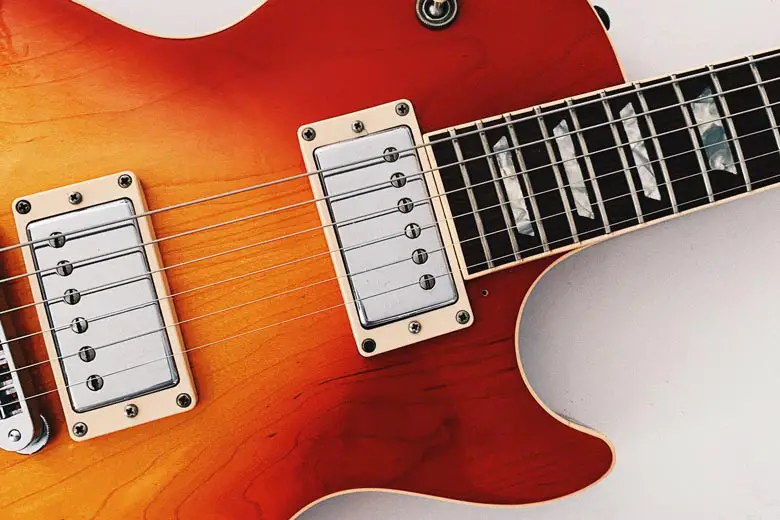
They have a higher output, sound darker, and emphasize the lower end of the sound, so they’re the weapon of choice for guitarists who make heavier music such as rock.
They are also typically louder than single-coil pickups.
There are a few variations of humbucker pickups, such as:
- Mini humbuckers
- Wide range humbuckers
- Triple buckers
- Filter Tron
- Active pickups
Mini Humbuckers
Mini humbuckers are, as the name suggests, small humbuckers. Their size changes how they interact with the strings, so their sound is significantly different from the one that comes from typical humbuckers.
They are much closer to single-coil pickups and have a scooped middle-end with a bright and clear top. Unlike the typical humbucker, they don’t emphasize the bass that much.
Wide Range Humbuckers
These humbuckers simply provide a higher range of sound than other humbuckers.

They offer carved-out mid-ranges and extra high tones, making them more versatile than regular humbuckers.
Fender created these pickups for their Telecaster Thinline to make a fancier guitar than the traditional Telecaster.
Triple Buckers
A triple bucker is a humbucker with one additional coil, hence the name. This extra coil allows them to produce a much more comprehensive range of sound.
Inside, you’ll find two coils that work as a typical humbucker, and when you turn on the third one, it adds a lot of mid-range sounds to the mix.
Filter Tron
Gretsch designed these pickups to eliminate the hum produced by single-coil pickups.

They’re very similar to typical humbuckers, but their coils are packed more tightly and have larger magnets.
They also create more high tones than typical humbuckers, making them more versatile. These higher tones are responsible for the recognizable Gretsch sound.
Active Pickups
Active pickups can be single-coils or humbuckers, but they mostly come in the humbucker variation.

“Active” here means that they’re powered by a battery, unlike typical passive pickups, which require no additional power source.
These pickups come with a preamp and create a lot of power and output. This feature is perfect for genres such as metal, in which you want as much power and volume as possible.
Still, these pickups allow you to cover the whole sound range, including both bottom and top.
Piezoelectric
One type of pickup that doesn’t fall under these two categories is piezoelectric pickups. These pickups use a piezo crystal, which is a type of crystal that converts vibrations directly into a voltage.
These pickups, however, are not very common.
They’re most common in acoustic and semi-acoustic guitars and some other string instruments, such as cellos, violins, and double basses.
They’re much more common in these other string instruments than in guitars.
These pickups are great if you want to imitate the sound of an acoustic guitar, but they’re notorious for their lack of a low end, which makes them have a harsh top.
Other Characteristics of Pickups That Influence Your Guitar’s Sound
Apart from the type of pickup, other technicalities will influence the sound your guitar produces, no matter which pickup you choose to put on it.
You’ll have to pay attention to each of these influences if you want to fine-tune your guitar sound.
These factors are:
- Material
- Size
- Proximity to the strings
- Position on the guitar
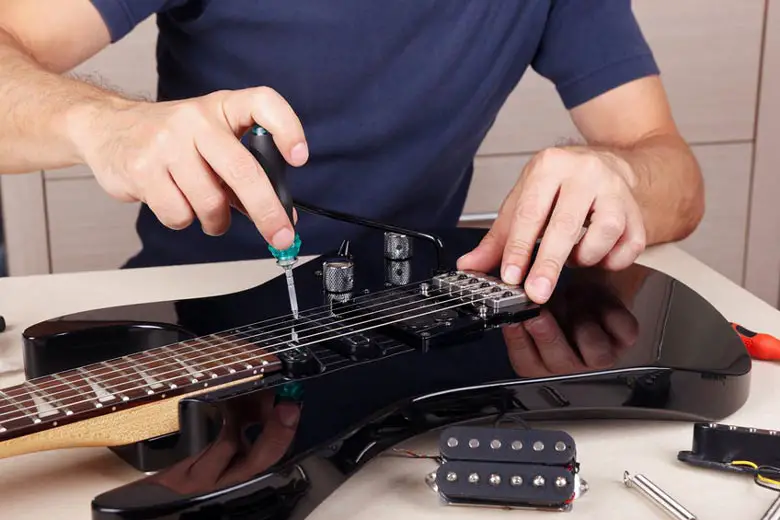
The Pickup’s Material
When it comes to the material, I’m primarily talking about what the magnet consists of.
There are two main types:
- Alnico: This type of magnet comes in several variations, but it’s a more exclusive and expensive material. However, it also produces a better sound, which is more variable and generally more pleasant for the ear.
- Ceramic: Ceramic magnets tend to be cheaper and are thus more often present in entry-level instruments. They sound harsher, but this is not always a bad thing – it can even be desirable in metal, punk, and similar genres.
The Size of the Pickup
The bigger the pickup, the bigger its magnetic field will be. So, a more significant portion of the string will interact with the magnet, which will allow the pickup to register more of its vibrations.
This extra surface area may result in a richer and more complex sound.
The Pickup’s Proximity to the Strings
How close you position your pickups to your strings will significantly influence the sound they create.
You should aim for a sweet spot, as they should not be too close or too far away.
If the pickups are too far away from the strings, there will not be enough volume, and you’ll have a weak, quiet sound. On the other hand, there will be too much distortion if they’re too close.
The Pickup’s Position on the Guitar
You’ve probably noticed that your sound changes when you move your picking hand between the bridge and the neck.
- The closer the pickup gets to the bridge, the brighter its sound will be and the more attack it will have.
- The sound will be warmer and more powerful as you move closer to the neck.
You can take advantage of these sound differences by moving your pickup up or down the guitar’s body. So, to emphasize warmer tones, go up. Move it a bit closer to the bridge for a more powerful sound.
Final Thoughts
There are many various pickups, most of which you can divide into the categories of single-coil and humbucker types. However, these styles have many variations, so each guitar will sound different.
Apart from that, pickups will sound different based on how big they are, where they are, what they consist of, and how close they are to an instrument’s strings.
You can move or switch pickups on the same guitar to create a different sound, so these small devices play a huge role in how your guitar will produce various tones.